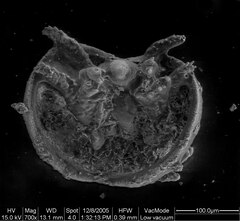
Back Fauna de Orsten Spanish הפאונה של האורסטן HE Fauna Orsten ID オルステン動物群 Japanese Orstenfaunan Swedish 奧斯坦型動物群 Chinese
| Orsten | |
|---|---|
| Stratigraphic range: | |
 Hesslandona angustata, a phosphatocopine, showing exceptional preservation in 3D | |
| Type | Geological formation |
| Unit of | Alum Shale Formation |
| Lithology | |
| Primary | Shale and limestone |
| Location | |
| Region | Kinnekulle and island of Öland |
| Country | Sweden |
| Type section | |
| Named for | Orsten[a] |
| Named by | Klaus J. Müller, 1975 |
The Orsten fauna are fossilized organisms preserved in the Orsten lagerstätte of Cambrian (Late Miaolingian[1] to Furongian) rocks, notably at Kinnekulle and on the island of Öland, all in Sweden.
The initial site, discovered in 1975 by Klaus Müller and his assistants, exceptionally preserves soft-bodied organisms, and their larvae, who are preserved uncompacted in three dimensions. The fossils are phosphatized and silicified, thus the delicate chitinous cuticle and soft parts are not affected by acids, which act upon the limestone nodules within which the fossils have survived. Acids dissolve the limestone, revealing the microfossils in a recovery process called "acid etching". To recover the fossils, more than one and a half tons of Orsten limestone have been dissolved in acid, originally in a specifically designed laboratory in Bonn, more recently moved to Ulm. The insoluble residue is scanned by electron microscope.[2] The phosphorus used to replace the fossils with calcium phosphate is presumed to be derived from fecal pellets.[3]
The Orsten fauna has improved the understanding of metazoan phylogeny and evolution, particularly among the arthropods, thanks in part to unique preservation of larval stages. The Orsten sites reveals the oldest well-documented benthic meiofauna in the fossil record. For the first time, fossils of tardigrades ("water bears") and apparently free-living pentastomids have been found.
The Cambrian strata consist of alum shales with limestone nodules (the Alum Shale Formation), which are interpreted as the products of an oxygen-depleted ("dysoxic")[b] marine bottom water habitat of a possibly offshore seashelf at depths of perhaps 50–100 m.[2] The bottom was rich in organic detritus, forming a soft muddy zone with floc in its surface layer.
Other Orsten-type preservation fauna have been found in Nevada, eastern Canada, England, Poland, Siberia, China and the Northern Territory of Australia.[4]
Cite error: There are <ref group=lower-alpha> tags or {{efn}} templates on this page, but the references will not show without a {{reflist|group=lower-alpha}} template or {{notelist}} template (see the help page).
- ^ Maas, A.; Mayer, G.; Kristensen, R. M.; Waloszek, D. (2007). "A Cambrian micro-lobopodian and the evolution of arthropod locomotion and reproduction". Chinese Science Bulletin. 52 (24): 3385. doi:10.1007/s11434-007-0515-3. S2CID 83993887.
- ^ a b C.O.R.E. Örsten site
- ^ Maeda, Haruyoshi; Tanaka, Gengo; Shimobayashi, Norimasa; Terufumi, Ohno; MATSUOKA, HIROSHIGE (2011-03-30). "Cambrian Orsten Lagerstätte from the Alum Shale Formation: fecal pellets as a probable source of phosphorous preservation". PALAIOS. 26 (3/4): 225–231. doi:10.2110/palo.2010.p10-042r. JSTOR 25835620. S2CID 131428775.
- ^ Waloszek, Dieter (19 February 2016). "'Orsten' on World-Wide Scale". Center of 'Orsten' Research and Exploration. Retrieved 29 November 2016.